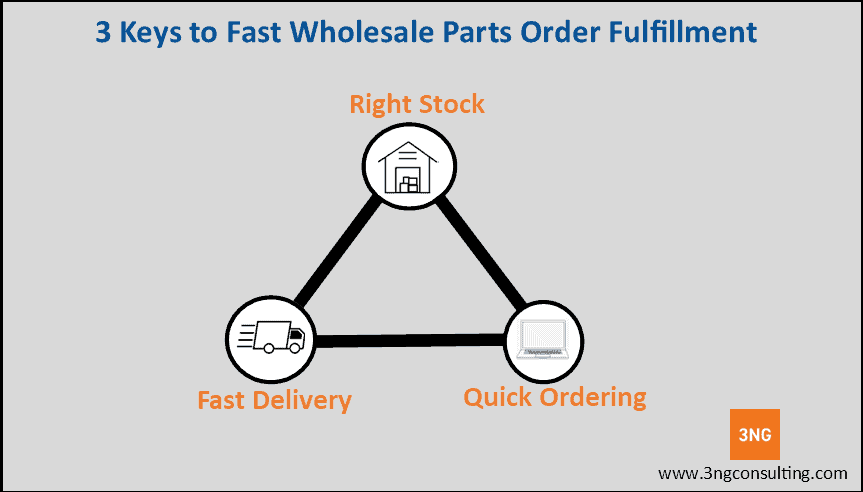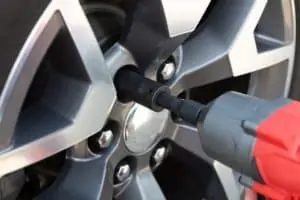Inventory solutions are the keystones for wholesale parts sales growth. Shops need parts quickly to maintain their profitability and it’s difficult for car dealerships to deliver parts to customers quickly without the right parts inventory management plan.
Market data shows that shops consistently rate speed of service as the #1 reason they buy parts from a wholesale supplier and there are 3 keys to fast service – fast response, fast delivery, and maintaining the right inventory levels.
And without all 3 in place, car dealers supplier cannot effectively provide the speed of service a wholesale shop needs.

Speed is Key to Sales Growth
Fast delivery is consistently rated the most important factor over price, quality, warranty and return policy. Shops need turnover to make a profit, and fast service helps them get the parts they need quickly. Parts Departments can’t receive, process and deliver the order if they don’t have the auto parts supply available.
Optimizing Inventory Planning
In the 1980s, prevailing thought in the automotive industry was to move inventory out to the end of the channel to maximize sales. So, dealers and the aftermarket distributors would consign inventory and offer bulk discounts to encourage their wholesale customers to buy and stock as much product as possible.
Inventory solutions have changed in the past 40 years. Today, auto manufacturers and aftermarket distributors have taken a different approach to planning inventory. So instead of pushing parts into the shops, supply chains have consolidated supply at key warehouses. T
his has reduced inventory throughout the supply chain by holding less inventory at a few key supply points. This inventory plan has benefitted the supply chain in many ways.
First, a well-planned JIT inventory reduces inventory investment and improves cash flow. This is because parts are carried in one warehouse instead of dozens. As a result, less money is tied up in carrying costs. Secondly, it reduces returns and improves ordering transparency and accuracy.
Third, JIT supply chains improve demand forecasting. This improves global supply efficiency and inventory holding costs. Consolidating supply helps distributors define regional SKU demand more closely and reduces total holding costs.
Change the Focus
Two key changes are needed if the OEM Parts Channel is going to capture aftermarket parts sales. First, dealer management must recognize that most Fixed OPS growth opportunity comes from the parts département, not the service department.
And maximizing part sales growth hinges on auto dealerships shifting their view of independent shops. In particular, at independent shops as customers and not competitors.
Secondly, Parts Managers will need to adapt their inventory planning process. Specifically, dealers will need to carry more inventory. But the increase in the amount of inventory carries risk and will need to be managed closely and carefully.
A Just in time – JIT inventory planning process tends to focus on restocking sold inventory and does not naturally recommend the addition of speculative inventory. So, dealers and automakers will need to supplemental data to ensure they are not pursuing too lean of an inventory strategy.
Next Steps
Dealers who want to carry the right inventory for independent shops will need to purchase inventory management software. They should also compare odealer management system stocking recommendations against third party sources. Fortunately, there are many dealer management software and data options available.
Parts Inventory Management Software
Dealer Management systems offer excellent parts inventory modules. However, they also rely upon good data to work properly. So, if inventory planning system isn’t tuned to look for lost wholesale sales, it won’t recommend the addition of key parts. So, parts will never be reordered because there is no reorder point set in the system.
Collect Demand Data Inputs
There are a lot of great data inputs available to dealers. The first is organic traffic. A lot of wholesale parts orders are not recorded as lost in the DMS system because they inquiry is never added. Improving discipline and ensuring countermen add lost part sales will help capture these parts and set a reorder point when the inquiry volume reaches minimum thresholds.
Another great option is to buy local demand data. Companies such as Epicor and Mitchell 1 have data services that provide part level demand data by zip code or dealer PMA. These provide a great list of parts your customers are buying from your competitors. Reviewing this data and setting a strategic stocking plan can help your dealership grow into the business.
One of the best places to start with car parts wholesale is with powertrain parts. So, add some high demand powertrain parts inventory and tell your customers that you are offering powertrain.
About 3NG Consulting
3NG Consulting offers automotive consulting services to help dealers and automakers increase sales. Our team has helped our clients capture over $3B in part sales – and growing. Call us today to see how we can help your business grow your sales.






